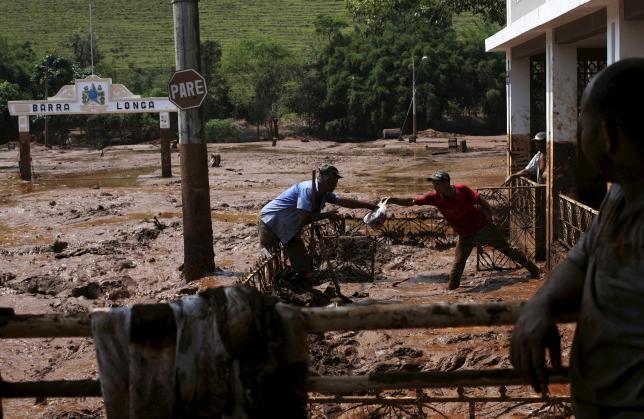Two dozen missing in vast mudflow of Brazil mine disaster
MARIANA, BRAZIL: Brazilian authorities late on Saturday were investigating a second suspected death after two dams at a major mine in the country's southeast burst and unleashed a massive mudflow that wreaked havoc across more than 80 km (50 miles).
A dozen residents of villages downstream from the burst dams remain missing, along with 13 workers from the mine. Officials warned of a higher death toll even as they struggle to find bodies probably swept away by the torrent.
One death from the disaster was confirmed on Friday, and authorities reported the body of someone believed to be a second victim on Saturday evening. A spokesman for the state fire department said they expected to be able to determine on Sunday if the body is that of one of the missing people.
"The death toll will rise for sure," said Duarte Júnior, mayor of Mariana. "Some people still aren't accounted for."
The city is near the hard-hit town of Bento Rodrigues, whose residents are still providing authorities with names of people believed missing.
City officials released a partial list of missing people, including three children aged 4 to 7 and a 60-year-old woman from the village, which was swamped by mudslides within a half-hour of public warnings after the dams burst on Thursday.
As rescue crews worked during the weekend, Brazilians once again raised longstanding questions about the regulatory rigor and the health and environmental risks of mining, one of the country's biggest industries and a key driver of exports.
The governor of Minas Gerais, the mineral-rich state whose name literally means "general mines," has already characterized the accident, which soaked much of the area beyond the dams with mine waste, as the state's worst-ever environmental disaster.
The mine's operator, Samarco, is co-owned by the world's largest mining company BHP Billiton Ltd and the biggest iron ore miner Vale SA Clean-up and repairs along miles of flooded river could cost the companies a fortune.
A state public prosecutor based in Mariana said on Saturday that he would seek 500,000 Brazilian reais ($130,000) in personal damages for each of about 200 families most affected by the dam burst.
While it is still unclear what caused the collapses, Samarco said Saturday that workers were doing normal scheduled work on one of the dams to increase its size when it burst and swept them away in the flood.
Walls of water cascaded downhill, engulfing the village of Bento Rodrigues and its 600 residents in a sea of mud while also flooding others far removed from the open-pit mine.
"They didn't tell us the mud would come through with such force," said Losangeles Freitas, resident of Barra Longa. The town nearly 80 kilometers downstream was flooded by the 60 million cubic meters of waste water and mud.
"We lost everything," she said. "It moved so fast."
Her neighbor, 58-year-old plumber Bernardo Trinidade, said authorities warned that the river behind his house would swell by a meter or two. But the waters rose more than 10 meters, he said, sweeping into his home at 3 a.m. - nearly half a day after the dam broke.
"We took what we could and ran upstairs," said Trinidade. "We were told it wouldn't be so bad."
Half a dozen jeeps with water and emergency supplies rolled through Barra Longa on their way to Gesteira, one of several remote villages along the river that rescuers had not yet reached.
ENVIRONMENTAL RISKS
As rescue teams labored to reach isolated communities, state officials were taking precautions to contain the environmental fallout from the burst dams.
The dams held back so-called tailings ponds, masses of finely ground waste rock and water left over from extracting more valuable minerals, which can contain harmful chemicals.
Civil defense officials said state sanitation authorities would test the toxicity of the rivers. Meanwhile, residents who came in contact with the thick mud were advised to shower and dispose of their clothing.
Samarco sought to play down those fears, saying there were no chemical elements in the tailings dams that posed health risks when the accident occurred.
Samarco's chief executive officer said the mine's environmental licenses were up to date and the dams had been inspected in July.
Executives have said a tremor in the vicinity of the mine may have caused the dams to burst, but it was too early to establish the exact cause.
Samarco said it had set no date to restart the mine, which produces about 30 million tons of iron ore annually. Output is shipped to Brazil's coast and converted into pellets for export to steel mills.
The cleanup bill and potential environmental lawsuits could be more costly than the loss of output. BHP Billiton and Vale already face the lowest iron ore prices in a decade.






